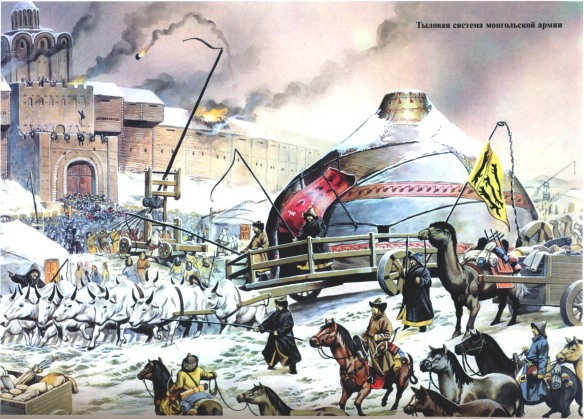The siege of Kiev, which ended on December 6, 1240, with the sack of the city, was the final great blow in the Mongol conquest of Russia.
On the eve of the Mongol invasion, Kiev was, despite political turmoil, still the mother-city of Russia (including Ukraine and Belarussia); whichever prince held Kiev became great prince of all Russia. After the Mongols under CHINGGIS KHAN’s grandson BATU (d. 1255) destroyed several cities of northern Russia—Ryazan’, Vladimir, Torzhok, and Kozel’sk—in 1238, the Mongols turned their attention to the steppe. In 1239 they advanced against southern Russia, taking Pereyaslavl’ and Chernihiv (Chernigov) south and north of Kiev. In 1240 Batu’s cousin MÖNGKE KHAN (1209–59), inspecting Kiev from across the Dniepr, sent an envoy summoning Prince Michael of Chernihiv, then holding Kiev, to surrender. Michael fled to Hungary, and no prince dared take command in the city; a commander of a 1,000 (tysiatskii), Dmitro, marshaled the final resistance.
After Batu crushed the “Black Caps” (Qipchaq[1] Turkish allies guarding Kiev’s southern approaches), the entire Mongol army camped outside Kiev under his command. Batu set up catapults near the southeast “Polish Gates,” where tree cover extended almost to the walls, and began several days of bombardment. On the eighth day the walls were breached, and hand-to-hand combat followed on the walls, where a Mongol arrow wounded Dmitro. The Mongols held their positions when night fell, while Dmitro and the Kievans walled the Church of the Blessed Virgin for a last stand. The next day, as the Mongols assaulted the church, the people crowded into the upper chambers, and the walls collapsed. The population was butchered, although Dmitro was spared for his bravery.
JOHN OF PLANO CARPINI, who visited the town in 1246, described the surrounding countryside as littered with skulls and bones and the town itself reduced to scarcely 200 houses. He found a Mongol commander of a 1,000 and several nobles there. No Russian prince made his seat there, leaving Kiev, unlike other Russian cities, with no buffer against direct Mongol rule.
Further reading: George A. Perfecky, trans., The Galician-Volynian Chronicle (Munich: 1973).
[1]The first Mongol contact with the Qipchaqs came after 1216, when Qodu, a defeated chieftain of the Mongol MERKID tribe, took refuge among the Ölberi chiefs by the Ural Mountains. The Ölberi rejected CHINGGIS KHAN’s (Genghis, 1206–27) demand to surrender the fugitive, and the khan dispatched SÜBE’ETEI BA’ATUR, who raided the Qipchaqs and killed Qodu before returning. After the Mongols’ great campaign against Khorazm, Sübe’etei and JEBE again swung north through Derbent to reconnoiter the territory. After they defeated the Qipchaqs of the Kuban steppe, the western Qipchaq leader Köten (Kotian, Kötöny) received aid from his Russian son-in-law Msitslav of Halych, but Jebe and Sübe’etei crushed the combined Russian-Qipchaq army at Kalka River (May 31, 1223) before turning east. Meanwhile, Chinggis Khan had assigned to JOCHI, his eldest son, the conquest of the Qipchaqs. Jochi (d. 1225?) subdued the Qangli by 1224 but refused to move west, angering his father.
In 1229 Chinggis’s son ÖGEDEI KHAN (1229–41) sent Kökedei and Sönidei to conquer the Qipchaqs and other people along the Volga River and in the Ural Mountains, such as the BULGHARS, Saqsin, and Bashkir (Bashkort). The Mongol force proved too small for the fierce resistance of the Qipchaq chief Bachman, and in 1235 Ögedei mobilized a much larger expedition headed by his nephews BATU (son of Jochi) and Möngke and his son Güyüg together with Sübe’etei. Some Ölberi Qipchaq chiefs surrendered and joined the Mongol army, but most fled the area; some joined Bachman’s guerrilla resistance. Möngke finally captured Bachman’s island base in the Volga delta in winter 1236–37. By autumn 1238 other princes had conquered the Qipchaqs of Crimea and the Ukrainian steppe. Köten led a large number of Qipchaqs in flight to Hungary, which the Mongols invaded next. Qipchaq chiefs in the Caucasus resisted until 1242.
